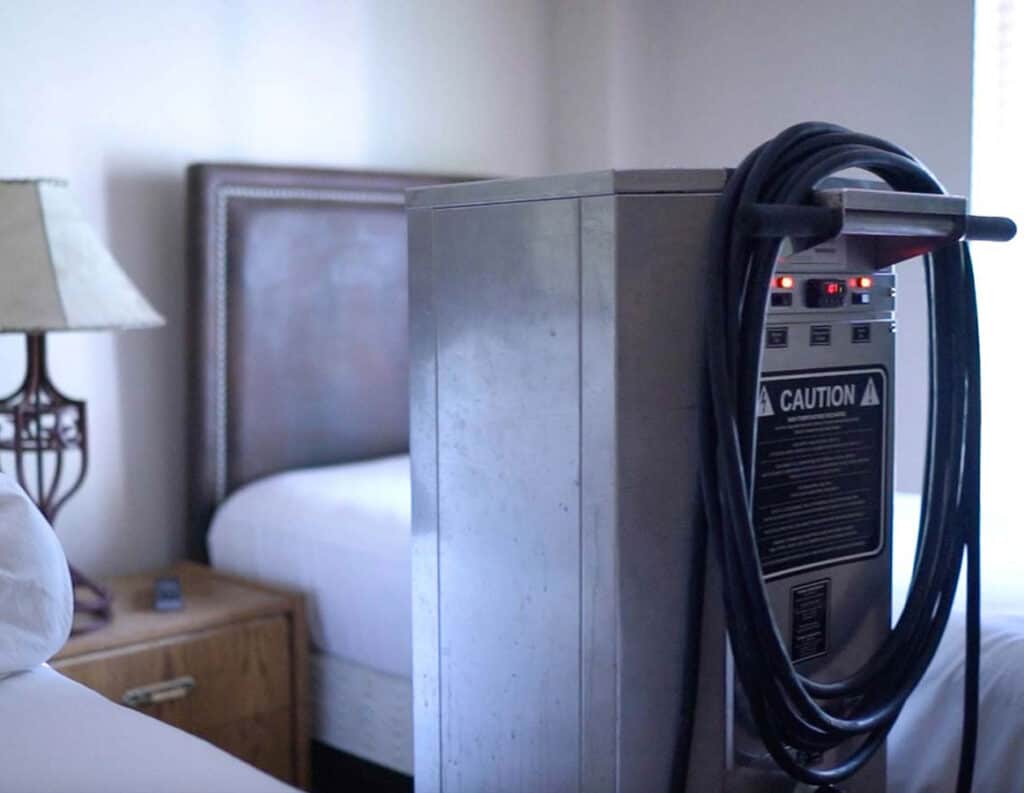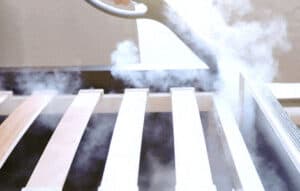Bed Bug infestation is a significant problem for many households all over the US. That includes here in New York where we have seen infestations increase from year to year. Whether it’s your mattress, box spring, carpet, or even your cabinet drawers, bed bugs can crawl virtually anywhere, creating problems for households. There are several ways to deal with bed bugs. We know that heat treatment is the most attractive method for many homeowners. But what are the adverse effects of different bed bug treatments? What are the best forms of bed bug treatment, and which ones should you adopt for your home?
Let’s take a look at what you need to know about how bed bug heat treatments work and how to approach your selection of which type of treatment is right for your infestation.
What Is Bed Bug Heat Treatment?
Bed bug heat treatment is the general term used when talking about the elimination of bed bugs by using high temperatures either in specific targeted locations, rooms or throughout the whole property to kill all the adults, nymphs and egg cycles. One reason homeowners are attracted to heat treatments is that many families are against harmful chemicals. For families conscious of chemicals, heat treatment is one alternative to reduce or eliminate toxic chemical exposure. Bed bug heat treatment with heaters refers to getting rid of the pests by raising the temperature of the infested room. It involves large, sophisticated machinery that can increase the heat levels in a room, making it impossible for bed bugs to survive under extreme conditions.
The specialized heat equipment requires proper monitoring throughout the treatment process, preventing or reducing the chances of accidents and fires. At the same time, it can kill the tiniest bed bugs and the developing eggs to prevent further infestation in the future.
Temperature Levels During Bed Bug Heat Treatment
Bed bugs die in about an hour and a half of exposure to extreme heat. The required temperature levels must be at least 120 degrees Fahrenheit. So, professional heat treatment companies maintain temperatures between 135-145 degrees when running bed bug heating equipment in a residential home. You will need an infrared thermometer to accurately monitor room temperature.
How Long Can It Take to Kill Bed Bugs with Heat Treatment?
The duration of effective treatment can vary from the area and nature of the problem. Generally, bed bugs and eggs die within 90 minutes of treatment. Most professional companies, however, will recommend six (6) to eight (8) hours of treatment to be safe and result in complete elimination.
Safety Considerations During Heat Treatment
Since the internal temperatures can get extremely high, removing any perishable items and furniture sensitive to high temperatures is essential. Damage to personnel or things in the home can happen during a bed bug heat treatment. This danger is especially true for plastics, leather imitation furniture, candles and anything that will melt at a high temperature. Extreme temperatures are not suitable for pets either, so plan to have all animals out of the home for an extended period. It’s best to evacuate the entire room before starting bed bug heat treatment in your house.
Other Types of Bed Bug Treatments
Heat treatments are the most effective method to get rid of bed bugs from literally any place in your house. But treatments are not always limited to heat treatments. Other techniques can get rid of bed bugs, and companies offer different solutions for households. Here is a look at some of the most typical bed bug treatment methods.
Insecticide Treatment
Perhaps one of the most common and cost-effective methods to get rid of bed bugs is insecticides. Homeowners should trust a professional company to perform these treatments due to exposure to harmful chemicals. Commercial bed bug products typically require operating companies to have special licensing to complete the treatment methods, especially indoors. And remember, just because you can buy it over the counter doesn’t mean it’s safe to breathe in and get on your skin.
There are many ways to perform insecticide treatment, but it’s a relatively lengthy process if done correctly compared to some of the other methods.
Insecticides can kill bed bugs from surfaces and smaller and unreachable areas. There are specific possible health hazards resulting from the interaction with these chemicals.
Generally, operators will use a spraying mechanism to disperse insecticide in an infested room. With this treatment method, a professional bed bug exterminator will instruct homeowners and pets to leave for 2.5 – 3 hours to reduce health risks and exposure. The operators will wear protective equipment to minimize exposure to the chemicals.
Types of Insecticides
Insecticides are classified into three categories to reduce health risks further.
- Fast-acting bed bug insecticides are for surfaces that come in regular human contact. These chemicals are fast action chemicals, immediately killing the bed bugs, leaving no chemical residue to reduce human interaction. These products offer low residual and limited exposure for homeowners. Location examples include furniture, doors, etc.
- Residual insecticides. These chemicals leave a specific residue to kill bed bugs inside furniture, crevices, cracks and undersides of objects which are not easily accessible.
- Dust insecticides. These are for smaller walls like cracks, holes and electrical outlets. They are generally liquid-free to avoid any chances of electrical hazards.
Insecticide bed bug treatments typically take more than one visit. The reason is the egg cycles and various stages of bed bug development. During the initial treatment it is rare to kill all the bed bugs. A single treatment session can take up to two hours, depending on room sizes and conditions.
After the treatment, you must wait before entering the room. Afterwards ventilate the room properly to let all the chemicals evaporate.
Pros of Insecticide Treatments
- Insecticide treatments are versatile and quick.
- They treat all possible forms of cavities and unreachable places.
- Don’t encounter problems like cold spots.
Cons of Insecticide Treatments
- Insecticides pose a particular health risk, so you must maintain proper distance for some time.
- Insecticides being liquid, making treating liquid-sensitive items like electronic gadgets and appliances challenging.
- Requires multiple sessions and visits from the treatment company to eliminate bed bugs from the infested area.
Freezing Techniques
An unpopular yet practical technique to kill bed bugs is to freeze them to death. You can put the infested items inside a freezer to kill pests and bed bugs. Interestingly, freezing bed bugs is remarkably easy, and you can do it at home without any professional help. All you need is to maintain a temperature under zero (0) degrees Fahrenheit. Then wrap the infested items inside plastic bags to prevent the bed bugs from coming in contact with the inside of the freezer. Keep a remote thermometer to monitor the right temperature.
You are limited to select items that can freeze. For instance, cloth, books, jewelry, toys are some things you can put inside the freezer.
On the other hand, avoid keeping items with LCD panels, condensation-prone electronic items, items with high-moisture liquid, etc., inside a freezer.
Freezing can be a long process. Generally, a freezing operation may take up to four days to generate effective results while always maintaining the desired temperatures. In addition, depending on how oversized the items are inside the freezer, it can take longer to kill the infested bed bugs.
Pros of Freezing Method
- Provides effective results.
- Doesn’t require any special equipment. You can use your household freezer for treatment.
- Free from insecticides.
Cons of Freezing Method
- It takes much longer than other methods.
- Not ideal for commercial purposes.
- Requires more energy due to longer duration.
- Only suitable for smaller infested items.
Steam Heat Treatment For Bed Bugs
Steam is considered an effective type of heat treatment for bed bugs. It can kill bed bugs at any stage of their life cycle. Generally, companies use a high-quality steamer for steam treatment. Steam treatment is a type of heat treatment because it uses the same principle for killing bed bugs. It may not work at the same temperature as other methods because steam has a relatively higher temperature.
Steam treatment works by exposing the bed bugs to steam. This way, it can kill off any bed bugs from the surface of furniture and mattresses, etc. In addition, since steam can penetrate up to a quarter of an inch into the fabric, it can kill bed bugs hiding in the most unreachable spots. This method can reach places where bed bugs hide, making it a great localized tool for bed bug steam treatment.
Steam can penetrate such tough spots and tiny gaps to get at the bed bugs hiding in cracks and crevices. In addition, the temperature with steam treatment can get appreciably higher than normal heat treatment, reaching up to 180 degrees F.
Pros of Steam Treatment
- The treatment can kill off bed bugs at any stage of their life cycle.
- The results have prolonged effects because no eggs or bed bugs can survive the extreme temperature.
- The process is quick because the bed bugs get killed instantly.
- It doesn’t require you to seal the room because it involves directly blowing off steam to the affected area.
Cons of Steam Treatment
- Steam treatment requires steamers which can be pretty expensive. A good-quality steamer can be very expensive, making it difficult for many people to use this treatment.
- Steam treatment can reach incredibly high temperatures, damaging sensitive home goods and furniture if you don’t know what you’re doing.
- Water leakages pose a severe threat to in-house safety, so you can’t do it yourself.
- There will be higher humidity in an affected room so that the moisture can affect sensitive electronic equipment inside the room.
Heat Chamber Technique
The heat chamber technique is another helpful technique to kill off bed bugs. This technique effectively eliminates them from household items like furniture, etc. The heating chamber is polystyrene foam. The chamber can be inside an infested room, and the infested items are placed inside the chamber. Once the items are in there, they are heat treated at extreme temperatures to kill off bed bugs and eggs inside the room.
Generally, a half an hour heating session is sufficient to kill the bed bugs inside the chamber. But while treating with heat chambers, there are a few precautions to be observed. Even though the bed bug heating chamber ensures no heat escape, make sure to use proper insulation for wooden or tiled floors. The heat chamber technique is relatively laborious, and it requires proper DIY skills to carry out the process effectively. At the same time, the area outside the heating chamber like the walls, cracks, crevices and baseboards must be treated with insecticides.
Once done, heat chamber treatment can leave long-lasting results, and it’s much cheaper than some of the other forms of bed bug heat treatment. It’s one of the reasons why many professional pest management companies use it for hotel rooms.
Pros of Heat Chamber Treatment
- Heat chambers have a portable design, easily movable from one room to another.
- Smaller chamber size makes it easier to achieve higher temperatures quickly.
- It’s highly cost-effective compared to the other forms of heat treatment.
- Preferable for commercial heat treatments because of small size and lightweight.
Cons of Heat Chamber Treatment
- Requires additional insecticide treatments which use chemicals. Not a standalone treatment.
- Not suitable for larger infested rooms because of limited chamber capacity.
- Damage to personal items when moving them and placing them in the chamber.
- It doesn’t treat cold spots, so there is a risk of reinfestation.
Whole Room Heat Treatments
If there are larger areas for treatment such as a hallway and bigger room, the whole room heat treatment can be the most efficient option. It’s a form of bed bug heat treatment, and it leaves a lasting impact, killing off all bed bugs and their eggs in one session.
Whole room heat treatment uses special machinery to increase the heat levels inside the room. Because the machine heats a larger area, it uses immense electrical power, making it expensive to solve pest problems. It’s comparably more effective than some other methods.
Typically, a high temperature is maintained through the machines. The operators ensure that the temperature remains within limits, using multiple thermometers to get accurate temperature readings.
Depending on the treatment area, it takes eight hours to kill the bed bugs. Once the session is over, the operators may apply residual insecticides to make sure that they cover the entire infested area and prevent further chances of pest growth.
Pros of Whole Room Heat Treatment
- Highly practical with long-lasting impacts.
- Even heating prevents any possibilities of cold spots.
- Leaves no harmful chemicals after the treatment.
- It doesn’t require covering up materials inside the infested room.
Cons of Whole Room Heat Treatment
- It uses heavy machinery which isn’t easily portable.
- Requires high electrical power.
- Not the most cost-friendly solution.
- It may require an additional insecticide treatment to cover up tiny areas.
Choosing the proper bed bug treatment can be a complicated process. Many families are focused on heat treatments. Unfortunately, these can come with minimal guarantees. Homeowners are concerned about chemicals, and rightly so. There are many effective organic and all-natural products on the market. It is essential to look at the cost and guarantee of different treatments when speaking to a bed bug extermination company.
Regardless of the materials, pests and bed bugs can infest any part of your house. Most professional companies will suggest at least guaranteeing your entire home and any vehicles associated with the property that may have an infestation. Mainly, if you have lots of stuff lying in cold and dark areas in your room, bed bugs can spread rapidly, causing irritation and discomfort while you sleep. Getting rid of bed bugs can be a frustrating process, however, thanks to some of our new combined treatment methods. Especially with steam heat treatment, you can say bye to bed bug problems, and we can guarantee it for long periods. So, ask us about the right solutions for you and our home.




